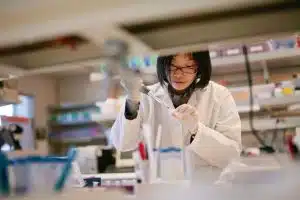15 STEM Extracurriculars That Impress College Admissions Officers
When aiming to gain admission to top-tier colleges and universities, displaying a strong commitment to STEM (Science, Technology, Engineering, and Mathematics) fields could significantly enhance a student’s application. Participating in STEM-related extracurricular activities showcases your passion for these subjects and demonstrates valuable skills like critical thinking, problem-solving, and innovation. In this article, we will discuss 15 STEM extracurriculars that can impress college admissions officers, highlighting various activities that could help students stand out in the competitive college admissions process.
From participating in robotics competitions and coding clubs to conducting independent research projects and internships at STEM-focused organizations, there are numerous ways for students to demonstrate their enthusiasm and proficiency in STEM fields outside of the classroom. These extracurricular activities allow students to deepen their understanding of STEM concepts and provide valuable hands-on experience and opportunities for leadership and collaboration.
15 STEM Extracurriculars That Impress College Admissions Officers
1. Boston University Summer Preview
- Location: Boston University
- Cost: $1,995
- Program Date: July 21 – July 26, 2024
- Application Deadline: Rolling basis
- Eligibility: Rising freshman and sophomore high school students
Aside from its academic focus, the Summer Preview program offers a mix of social activities designed to familiarize students with both Boston University and the vibrant city of Boston. Whether students choose to commute or reside on campus (note that residential students must be at least 14 years old at the program’s commencement), they will have the opportunity to participate in diverse group activities and workshops, including sessions on college admissions.
This aspect can be advantageous as students prepare for their future college endeavors. While the program does not provide college credit, participants will receive a certificate of completion and a letter of evaluation from their instructor. However, it’s important to note that financial aid is not available for this program, and the participation fee is $1,896, with a student contribution of $99.
2. Engineering Summer Academy at Penn
- Location: University of Pennsylvania
- Cost: $7700
- Program Date: July 7 – July 27, 2024
- Application Deadline: April 5, 2024
- Eligibility: Students 15 years old and above
ESAP caters to driven students, providing them with hands-on experiences across various engineering disciplines. Eligibility requires completion of at least freshman year of high school and a minimum age of 15 at the program’s commencement. A robust academic background, particularly in math and science, is imperative.
International applicants must demonstrate English proficiency via TOEFL scores or a school endorsement letter. The application process entails submitting an online application, high school transcripts, two letters of recommendation, and an application fee.
3. B.E.S.T. Robotics Design
- Location: Various regional locations
- Registration Fee: Not specified
- Important Date: Competition in Sep-Oct
- Eligibility: Middle and High School students in the U.S., part of a BEST Robotics club.
BEST Robotics stands out as one of the leading engineering and robotics extracurricular competitions for high school students, dedicated to promoting hands-on STEM education. In this competition, participants undertake the exciting challenge of conceptualizing and constructing a machine using a specified kit of materials, all within a rigorous six-week timeframe. This program emphasizes the Engineering Design Process, a fundamental skill for aspiring engineers. It encourages critical thinking and effective problem-solving.
BEST Robotics is a competition that brings together over 18,000 students annually from more than 850 schools. The competition values teamwork and innovation as much as technical skills. It has a regional format that allows many students to participate and showcase their talents. This makes the competition accessible to a broad range of students.
4. Future City Competition
- Location: Regional competitions across the U.S. and internationally; finals in Washington, D.C.
- Registration Fee: Not specified
- Important Dates: Regional competitions in January; finals in February.
- Eligibility: Middle school students (grades 6-8)
The Future City Competition is a celebrated event in the world of engineering and robotics contests for high school students. It serves as a project-based learning opportunity where participants undertake the task of envisioning and constructing cities of the future.
The theme for the 2023-2024 edition, “Electrify Your Future,” presents a challenge for teams to imagine cities powered entirely by clean, renewable electricity. Each team, comprising students, an educator, and a mentor, must develop a city essay, a scale model, a project plan, and a presentation.
Promoting sustainable solutions and nurturing creativity and collaboration, the competition culminates in regional contests and a national final held in Washington, D.C. Its distinguishing feature lies in its inclusivity, with substantial involvement from female students and underrepresented communities.
5. Intel International Science and Engineering Fair (ISEF)
- Location: Los Angeles, California (2024)
- Registration Fee: Not explicitly mentioned, but participants generally have to qualify through affiliated fairs which may have their own fees.
- Important Dates: May 11-17, 2024
- Eligibility: Students in grades 9-12 or equivalent must not have reached age 20 on or before May 1 preceding.
The Intel International Science and Engineering Fair (ISEF) distinguishes itself as a leading science competition for high school students on a global scale, offering an opportunity for budding innovators to display their scientific skills and talents.
Set to take place in Los Angeles, California, from May 11-17, 2024, this event brings together students in grades 9-12 worldwide, provided they have not reached the age of 20 on or before May 1 preceding the fair.
As a program under the Society for Science & the Public, ISEF enjoys widespread recognition for its international reach, attracting participants who have previously excelled in affiliated local, regional, or state science fairs. These talented individuals then have the opportunity to present their research projects across a spectrum of scientific categories, encompassing fields from engineering and mathematics to physics and other STEM disciplines.
6. You Be The Chemist Challenge
- Location: Varies (regional challenges); National Challenge in Houston, TX
- Registration Fee: Not specified
- Important Dates: Regional Challenges from January 19 to March 10, 2024; National Challenge on June 10 & 11, 2024
- Eligibility: Middle school students (grades 5-8)
Organized on an annual basis, the challenge aims to ignite enthusiasm for chemistry and its real-world implications, thereby nurturing the next generation of STEM professionals. It is designed as a multi-tiered competition, featuring both in-person and virtual tracks, ensuring accessibility to students regardless of their geographical location.
For those involved, the You Be The Chemist Challenge represents more than just a contest; it serves as a once-in-a-lifetime journey towards exploration and education, creating an engaging atmosphere where young intellects are motivated to explore the amazing field of chemistry.
This event, one of the best STEM extracurriculars, plays an important role in shaping participants’ comprehension of science and its practical implementations, propelling them toward future scientific pursuits. The Challenge greatly contributes to the holistic educational journey of its contenders by providing academic advancement and laying the groundwork for prospective careers in science and technology.
7. MIT THINK Scholars Program
- Location: Massachusetts Institute of Technology, USA (for the final event)
- Registration Fee: Not specified
- Important Dates: Applications open in early November and close in early January; the project is due in June
- Eligibility: High school students residing in the US
The MIT THINK Scholars Program is a special science competition for high school students that makes it an excellent STEM extracurricular. It’s run by undergraduates at MIT and focuses on encouraging young people to do innovative scientific research. It’s for high school students in the U.S. who are interested in STEM subjects (Science, Technology, Engineering, and Mathematics). Students need to come up with and send in a detailed research plan on a new idea in one of these fields.
The program ends with a free trip to MIT for the finalists. They get to present their finished projects there. This is a great chance for students to experience what it’s like to do research at college and meet other smart STEM students.
The THINK Scholars Program helps young scientists and engineers grow by giving them the support they need to improve their skills and be part of the science community. It’s a fantastic opportunity for high schoolers to challenge themselves, follow their love for science, and get recognized for their creative ideas and hard work.
8. Regeneron Science Talent Search
- Location: Finals in Washington, D.C.
- Registration Fee: Not specified; requires a detailed application
- Important Date: The 2024 competition finals are from March 6-13, 2024.
- Eligibility: High school seniors in the U.S., including U.S. citizens studying abroad
Every year, participants conduct their research, which they enter to compete for substantial scholarships and national acknowledgment. Finalists are selected based on the scientific quality and potential impact of their projects, often addressing critical issues in various STEM fields.
At the final event in Washington, D.C., these budding scientists go through evaluation, engaging with respected scientists and presenting their work to the public. This competition is an example of STEM extracurriculars that pushes students intellectually and nurtures a community of youthful innovators ready to make substantial contributions to their respective fields.
9. Discovery Education 3M Young Scientist Challenge
- Location: Final event at the 3M Innovation Center, St. Paul, Minnesota
- Registration Fee: Not mentioned
- Important Dates: Entries open until May 2, 2024; Final event on October 14-15, 2024
- Eligibility: Students in grades 5-8 in the US
The Discovery Education 3M Young Scientist Challenge is a well-respected science competition for middle school students. It’s specifically for kids in grades 5-8 and is considered the top science contest in the country for this age group. Sponsored by 3M and Discovery Education, this challenge encourages students to show off their creativity and problem-solving skills in science.
The finalists in this challenge get a special chance to work with a 3M scientist, getting important guidance and learning about real scientific research and development. The winner, known as “America’s Top Young Scientist,” gets a big scholarship, helping them further their education and career in science. This challenge is a learning adventure that encourages kids to grow intellectually and sparks a greater interest in science and technology.
10. Penn Summer Science Initiative
- Location: University of Pennsylvania, Philadelphia, Pennsylvania.
- Cost: Free
- Program Dates: July 8 – August 1, 2024
- Application Deadline: March 1, 2024
- Eligibility: Junior or senior year of high school from the greater Philadelphia area.
The Penn Summer Science Initiative, operated by LRSM, is a no-cost, month-long summer program designed for high schoolers keen on materials science and engineering. It commenced in 1993 and typically admits around 24-28 students annually, primarily juniors, from schools close to Philadelphia. The program comprises lectures, lab work, and field trips, all centered on materials science. Students engage in hands-on activities and explore various scientific methods.
This initiative welcomes students from nearby regions, particularly those from underrepresented backgrounds in science. This includes students from Philadelphia’s school district, females, minorities, and individuals with disabilities. The aim is to inspire students to explore and engage with science.
11. Aspiring Scientist Summer Internship Program at George Mason University
- Location: College of Science, George Mason University, Fairfax, Virginia.
- Cost: Free ($25 application fee)
- Program Dates: June 18-August 9, 2024
- Application Deadline: February 11, 2024
- Eligibility: Remote, in-person, or hybrid internships: 15 years or older; “wet-lab” in-person or hybrid internships: 16 years or older.
The Aspiring Scientist Summer Internship Program (ASSIP) at George Mason University offers a no-cost summer opportunity for high school and college students passionate about science, technology, engineering, and math (STEM). Participants have the chance to work in state-of-the-art research laboratories across various George Mason University campuses, gaining practical experience in fields such as environmental science and bioinformatics.
ASSIP provides an invaluable opportunity for young scientists to learn directly from seasoned professionals and utilize cutting-edge technology. More than just acquiring knowledge, participants actively contribute to authentic scientific research. This experience can enhance college applications and guide future career paths in the field of science. The program covers many areas, including astronomy, environmental science, and cybersecurity, providing a comprehensive overview of STEM disciplines. Engaging in ASSIP can lead to exciting prospects, such as publishing research and a successful career in science.
12. Student Science Training Program at the University of Florida
- Location: Center for Precollegiate Education and Training, University of Florida, Gainesville, Florida.
- Cost: $5200 ($50 application fee)
- Program Dates: June 9 – July 27, 2024
- Application Deadline: no deadline (selection will begin March 2024)
- Eligibility: Students entering senior year and at least 16 years old.
The University of Florida Student Science Training Program (UF SSTP) is a rigorous seven-week opportunity designed for high school seniors aged 16 and above with a keen interest in science, medicine, mathematics, computer science, or engineering. It is an ideal setting for engaging in STEM extracurriculars. Participants engage in collaborative research projects alongside university scientists. Successful applicants should demonstrate maturity, independence, and a genuine passion for research.
The program offers an intensive and dynamic experience. Students dedicate 30 hours per week to research activities, attend lectures on current research trends, and participate in specialized honors seminars. Additionally, they develop essential skills such as teamwork, leadership, and communication through various interactive exercises. Florida high school students can also earn dual enrollment credit through participation in UF SSTP.
13. Smith Summer Science And Engineering Program
- Location: Smith College
- Cost: $4,745 – $8,082
- Program Dates: July 6 – July 19, 2024 & July 21 – August 3, 2024
- Application Deadline: May 15, 2024
- Eligibility: Students entering 9th-12th grade in the fall of 2024
The Smith Summer Science and Engineering Program (SSEP) at Smith College is an esteemed residential program lasting four weeks, tailored for high school students, particularly young women, with a keen interest in science, engineering, and medicine. Taking place in July, the program annually welcomes over 100 students from various parts of the United States and offers an immersive experience blending hands-on research with academic learning. Participants get the special chance to collaborate directly with Smith faculty on projects spanning life and physical sciences as well as engineering.
Since its inception in 1990, this program has hosted nearly 1,800 students from 46 states and 53 countries, equipping them with enhanced readiness for advanced science courses in high school and a clearer vision of college expectations. Admission to SSEP is competitive, seeking students who demonstrate strong academic performance through STEM extracurriculars, motivation, and a desire for exploration. The application process entails providing academic records, a personal statement, and a teacher recommendation. Financial assistance is available for eligible students, ensuring the program remains accessible to a diverse range of participants.
14. Research Internship Program In Science And Engineering
- Location: Boston University
- Cost: $5,570 – $8,558
- Program Dates: June 30 – August 9, 2024
- Application Deadline: February 14, 2024
- Eligibility: Junior high school students
Running from June 30 to August 9, 2024, this six-week program invites participants to conduct research in university laboratories under the guidance of esteemed faculty, post-doctoral fellows, and graduate students. RISE offers two distinct tracks: the Internship and the Practicum.
In the Internship track, students engage in hands-on research spanning various fields such as astronomy, biology, biomedical engineering, chemistry, and computer science. With a commitment of 40 hours per week, this track provides an intensive experience to hone technical and analytical skills. On the other hand, the Practicum track is tailored for those interested in computational neurobiology. It includes comprehensive lectures and four hours of daily group research, focusing on computational modeling of neural systems. Both tracks culminate in a Poster Symposium, where participants showcase their research findings.
15. Summer High School Academic Program for Engineers
- Location: Columbia University
- Cost: $5,500
- Program Dates: July 8 – July 26, 2024 & July 29 – August 16, 2024
- Application Deadline: March 26, 2024
- Eligibility: Sophomores, juniors, seniors, and recent high school graduates
The program unfolds across two three-week sessions during the summer of 2024, from July 8 to July 26 and from July 29 to August 16, aiming to cultivate enthusiasm and competence in science, technology, engineering, and mathematics (STEM).
Participation in SHAPE entails immersing oneself in a challenging academic atmosphere that harmonizes theoretical learning with hands-on practice. You’ll dive into a diverse range of courses, spanning from Biomedical Engineering, offering practical laboratory engagement, to Competitive Programming, sharpening problem-solving abilities within a computing framework.
What are the best extracurricular activities for college?
Determining the “best” extracurricular activity for college can vary greatly depending on an individual’s interests, strengths, and goals. However, here are six examples of extracurricular activities commonly valued by colleges, along with explanations for each:
Leadership Roles in Student Government: Joining student government or taking on leadership roles within it demonstrates qualities such as communication skills, teamwork, and the ability to organize and manage events. Colleges appreciate students who actively contribute to their school community and take on responsibilities beyond academics.
Sports Teams or Athletic Activities: Participating in sports teams or athletic activities showcases dedication, teamwork, and leadership. Whether it’s varsity sports, intramural leagues, or individual sports like tennis or swimming, colleges value the discipline and time management skills required to balance athletics with academics.
Community Service and Volunteering: Engaging in community service demonstrates a commitment to making a positive impact beyond oneself. Volunteer work can take many forms, such as tutoring, organizing charity events, or participating in community clean-ups. Colleges appreciate students who show empathy, compassion, and a desire to give back to their communities.
Academic Clubs and Competitions: Joining academic clubs or participating in competitions related to your interests, such as science fairs, math competitions, or debate clubs, showcases intellectual curiosity and passion for learning. Colleges value students who actively seek out opportunities to challenge themselves academically and engage with subjects beyond the classroom.
Arts and Creative Endeavors: Involvement in the arts, such as music, theater, visual arts, or creative writing, demonstrates creativity, dedication, and discipline. Whether it’s participating in school productions, art exhibitions, or music performances, colleges appreciate students who pursue their passions and express themselves creatively.
Internships, Research, or Work Experience: Gaining real-world experience through internships, research opportunities, or part-time work demonstrates initiative, practical skills, and a commitment to exploring potential career paths. Whether it’s interning at a local business, conducting research with a professor, or working part-time to gain financial independence, colleges value students who take proactive steps to gain hands-on experience and develop professional skills.
Ultimately, the “best” extracurricular activity for college is one that aligns with your interests, passions, and personal goals, and allows you to demonstrate qualities and skills that are meaningful to you and valued by colleges. It’s important to pursue extracurricular activities that you are genuinely interested in and committed to, rather than simply trying to impress admissions committees.
Why are extracurriculars important to college admissions officers?
Extracurricular activities are important to college admissions officers for several reasons:
Demonstrated Passion and Interest: Extracurricular activities provide a glimpse into a student’s interests, passions, and values outside of academics. By participating in activities outside the classroom, students can showcase their dedication to specific interests or causes, demonstrating qualities such as commitment, enthusiasm, and initiative.
Holistic Assessment: Admissions officers strive to evaluate applicants holistically, considering not only academic achievements but also personal qualities, character, and potential contributions to the campus community. Extracurricular involvement allows admissions officers to gain a more comprehensive understanding of a student’s abilities, talents, and personality beyond what can be conveyed through grades and test scores alone.
Leadership and Initiative: Many extracurricular activities offer opportunities for students to take on leadership roles, organize events, and demonstrate initiative. Admissions officers value students who show leadership potential, as well as those who take initiative to pursue their interests, solve problems, and make positive contributions to their school or community.
Diversity and Inclusivity: Admissions officers seek to build diverse and inclusive student bodies, representing a wide range of backgrounds, experiences, and perspectives. Extracurricular involvement allows students to showcase their unique talents, experiences, and cultural backgrounds, enriching the overall campus community.
Skills Development: Participation in extracurricular activities can help students develop a variety of valuable skills, such as teamwork, communication, time management, and critical thinking. These skills are not only important for success in college but also for future career success and personal growth.
Demonstrated Impact and Contribution: Admissions officers are interested in applicants who have made meaningful contributions to their school, community, or broader society through their extracurricular involvement. Whether through volunteer work, community service projects, or leadership roles, students who can demonstrate a positive impact and a commitment to making a difference are often viewed favorably by admissions committees.
Overall, extracurricular activities play an important role in the college admissions process by providing admissions officers with valuable insights into a student’s interests, abilities, character, and potential contributions to the campus community. They allow students to showcase their passions, talents, and leadership abilities while also developing important skills and making a positive impact on their communities.
In conclusion, participating in STEM extracurricular activities can greatly enhance a student’s college application by demonstrating their passion, dedication, and skills in these critical fields. Beyond academic achievements, admissions officers seek well-rounded individuals who have actively engaged with their interests and made meaningful contributions to their communities.
By showcasing involvement in STEM extracurriculars, students not only distinguish themselves from their peers but also signal to colleges their readiness to tackle complex challenges and make a positive impact in the ever-evolving world of science and technology. Ultimately, investing time and effort in STEM extracurriculars not only impresses college admissions officers but also sets students on a path toward academic success and future career opportunities in STEM-related fields.











































